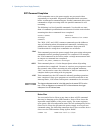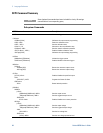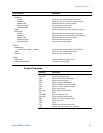4 Operating the Power Supply Remotely
58 Series N5700 User’s Guide
SCPI Commands – an Introduction
SCPI (Standard Commands for Programmable Instruments) is an
ASCII-based instrument command language designed for test and
measurement instruments. SCPI commands are based on a
hierarchical structure, also known as a tree system. In this system,
associated commands are grouped together under a common node or
root, thus forming subsystems. Subsystem commands perform
specific power supply functions. A portion of the SOURce subsystem
is shown below to illustrate the tree system.
[SOURce:]
CURRent
[:LEVel]
[:IMMediate] <NRf+>
:TRIGgered <NRf+>
:PROTection
:STATe <Bool>
SOURce is the root keyword of the command, CURRent is a second-
level keyword, LEVel and PROTection are third-level keywords, and
IMMediate, TRIGgered and STATe are fourth-level keywords. Colons
(:) separate higher-level from lower-level keywords.
Syntax
The following command syntax is used in this manual:
Square Brackets [ ] Items within square brackets are optional. The representation [SOURce:]VOLTage
means that SOURce: may be omitted.
Angle brackets < > Items within angle brackets are parameter descriptions. For example, <NR1>
indicates a specific form of numerical data.
Vertical bar | Vertical bars separate alternative parameters. For example, VOLT | CURR indicates
that either "VOLT" or "CURR" can be used as a parameter.
The syntax characters cannot be included in the command string.
Multiple Commands in a Message
Multiple SCPI commands can be combined and sent as a single
message with one message terminator. There are two important
considerations when sending several commands within a single
message:
Use a semicolon (;) to separate commands within a message.
There is an implied path that affects how commands are
interpreted by the power supply.
The command path can be thought of as a string that gets inserted
before each keyword within a message. For the first command in a
message, the path is a null string. For each subsequent command the
path is defined as the characters that make up the keywords of the


















